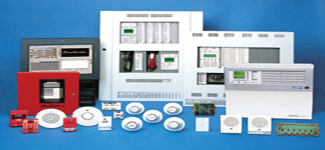Fire alarm systems are to detect the fire at the time of its onset, to direct the intervention units with the warning elements, to warn the extinguishing systems, if any, and to disable the dangerous units in the environment. It is possible to produce solutions for almost every application area by using various types of detection elements (workplaces, warehouses, houses, hotels, factories, schools, hospitals, etc.). Fire detection systems are frequently used in the places listed above.
Fire Alarm Systems, in the simplest sense, have a fire Detection panel. The panel displays warnings, flashes, etc. from various types of detection elements (detectors (Smoke Detector, Heat detector, Multi-Sensor, Flame detector, etc.), buttons, etc.) Fire Detection Systems are evaluated in two separate sections in terms of working principle.
1- Conventional Fire Detection Systems,
2- Analog Addressed Fire Detection Systems.
1-Conventional Fire Detection Systems:
The detection panel used in Fire Alarm Systems consists of areas where detection elements are connected. The number of zones is related to the capacity of the panel. (2….64 or More) 20 detection elements (detectors) can be connected to each zone. The panel also has inputs and outputs to connect fire alarm buttons and sirens. When any detector detects or when the fire alarm button is pressed, a warning signal comes from the region the detection element belongs to on the panel. For example: When any detector detects in a region where 30 detectors are connected, a warning will come from that region. (But it will not be clear from which detector the warning came.) This type of Fire alarm panels are used in small and medium-sized buildings.
2-Address Fire Detection Systems:
In addressable systems, there are loop lines to which sensing elements are connected. The number of loop lines and the wiring distance depend on the panel used. 128 addressable elements (detector, button) can be connected to a loop line. The sensing elements in the loop can be divided into zones within themselves, and each sensing element can be individually detected by the panel thanks to the addressing switch it contains. In other words, when any detector detects, the detector's location can be individually detected on the panel. Conventional systems and addressable systems are selected and sized according to their application locations. Conventional elements are sufficient and offer inexpensive solutions for systems that contain a small number of detection elements. This type of fire alarm panels are mostly used in large-scale buildings. Addressable fire alarm panels are of two types, Adreverse Fire alarm panels, Adresterial Fire alarm panels, Adresterial Fire alarm panels, Fire alarm panels. In detection systems, addressing is done with switches over detectors. In electronic addressable fire detection systems, the addressing is automatically assigned by the panel.
FIRE DETECTION SYSTEM ELEMENTS
Ionization Smoke Detector:
In the initial phase of the fire, it is activated when invisible smoke particles are detected by the double chamber sensor. This detector is not affected by changes in the temperature and humidity of the environment.
Optical Smoke Detector:
In slow and growing fires, it is activated by the detection of larger smoke particles by the optical sensor. This detector is not affected by changes in the temperature and humidity of the environment.
Combined Optical Smoke and Temperature Detector:
The EFS306 has optical detection and also a constant temperature sensor (60oC). This type of detector, which is activated when the temperature rapidly exceeds a certain limit, is ideal to guarantee detection in environments where a possible fire is expected to develop slowly.
Constant Temperature Detector:
There is a standard version activated at 60oC and a high temperature version activated at 90oC (for kitchen, boiler room, etc.).
Temperature Increase Rate Detector:
In the event of a fire, it is activated by rapid changes in the ambient temperature, as well as its feature of being activated immediately at 60oC.



